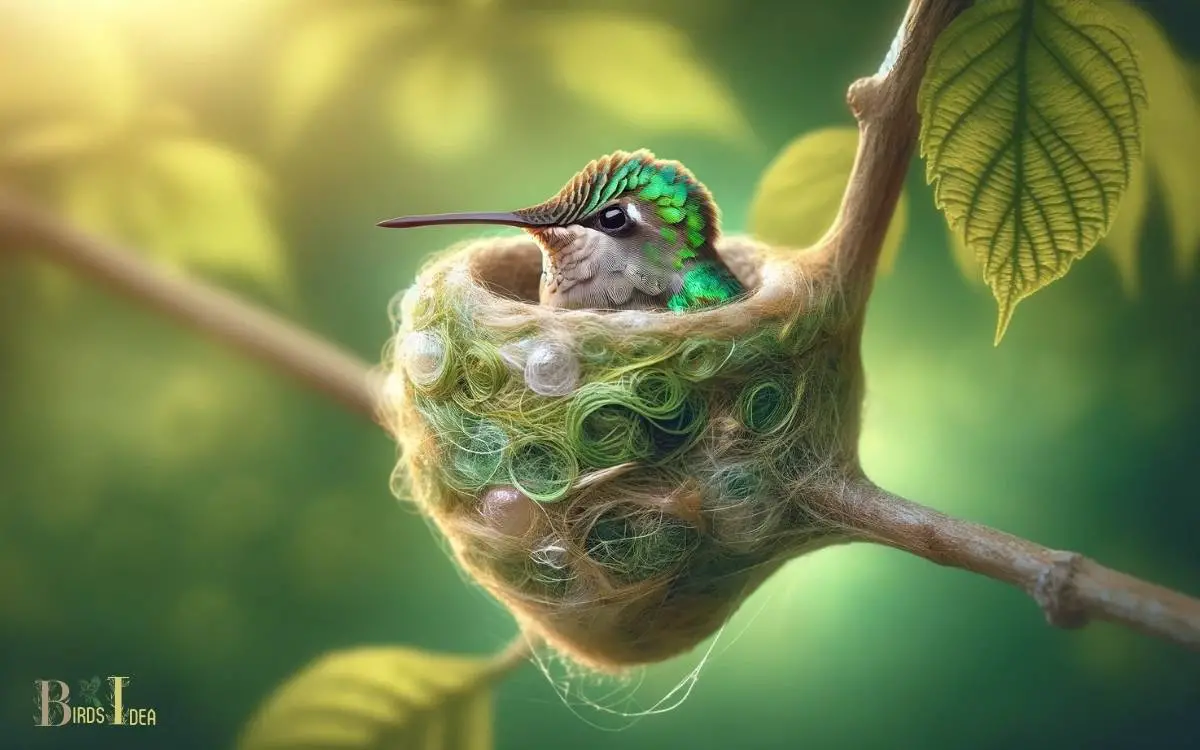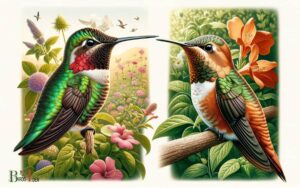Ruby Red Throated Hummingbird Nest: Explore!
The Ruby-throated Hummingbird (Archilochus colubris) often constructs its nest on a small, downward-sloping tree limb.
The nest, crafted primarily from spider silk and plant materials, is camouflaged with bits of lichen and moss, making it challenging to spot.
It is cup-shaped, stretchy, and when completed, roughly the size of a half-dollar coin. Female Ruby-throats usually lay two white, pea-sized eggs in the nest.
Ruby-throated Hummingbirds are known for their distinctive red throat (in males) and are common across eastern North America during the breeding season.
When building their nests:
For example, a hummingbird might use the silk from orb weaver spiders to create the base of the nest, incorporating dandelion or thistle down to line the interior for insulation and comfort for the hatchlings.
Spotting a Ruby-throated Hummingbird nest can be a delightful yet rare experience due to its small size and the meticulous craftsmanship of the female hummingbird blending it seamlessly into its surroundings.

Key Takeaway
Habitat and Location
The Ruby Red Throated Hummingbird typically builds its nest in the spring, selecting locations with ample sunlight and protection from predators.
These tiny birds often choose spots with overhead coverage, such as the branches of tall trees or shrubs, to shield their delicate nests from rain and direct sunlight.
The female hummingbird meticulously weaves together soft plant fibers, such as dandelion or thistle down, and covers the exterior with bits of lichen or moss to camouflage the nest from potential threats.
Their preferred locations for nesting are often near sources of nectar, such as gardens rich in nectar-producing flowers, providing easy access to food for both the mother and her chicks.
This strategic nesting behavior allows the Ruby Red Throated Hummingbird to thrive in its natural habitat, ensuring the survival of the species.
Nest Construction Process
During nest construction, the female Ruby Red Throated Hummingbird meticulously weaves together soft plant fibers to create a secure and camouflaged nesting structure.
The process involves several fascinating steps:
- Gathering: The female hummingbird collects materials such as plant down, moss, and lichens, using her beak to carefully select the softest and most pliable pieces.
- Weaving: With remarkable dexterity, the hummingbird intertwines the gathered materials, creating a strong, flexible, and elastic structure that can expand as the chicks grow.
- Camouflaging: To protect the nest from predators, the female adorns the exterior with bits of bark, leaves, and lichens, expertly blending it into the surrounding environment.
- Lining: Finally, the female lines the interior of the nest with downy feathers and soft plant fibers, providing a cozy and insulating environment for her eggs and chicks.
Nesting Materials
One of the essential components for the construction of the Ruby Red Throated Hummingbird nest is the collection of soft plant fibers, moss, and lichens by the female hummingbird.
These materials are meticulously woven together to form a strong and flexible nest, capable of withstanding the weight of the growing chicks.
The soft plant fibers provide a cushioned interior, ensuring the delicate eggs and hatchlings are protected from the elements.
Additionally, the use of moss and lichens helps to camouflage the nest, providing natural camouflage from predators.
The selection of these nesting materials highlights the remarkable adaptability and resourcefulness of the Ruby Red Throated Hummingbird, showcasing how these tiny birds utilize natural resources to create a safe and nurturing environment for their young.
Nesting Site Selection
Site selection for nesting by the Ruby Red Throated Hummingbird begins with a meticulous assessment of available locations.
This process involves several key factors:
- Protection: The hummingbird seeks a site that offers protection from predators and adverse weather conditions.
- Availability of Food: Proximity to nectar sources and small insects is crucial for sustaining the breeding female and her young.
- Camouflage: The site must provide adequate cover and camouflage to shield the nest from potential threats.
- Accessibility: The hummingbird selects sites that allow for easy access and egress, enabling quick and efficient foraging trips.
These considerations ensure the survival and well-being of the nesting hummingbird.
Nesting Season
The meticulous site selection process leads the Ruby Red Throated Hummingbird seamlessly into the nesting season, during which it meticulously constructs its nest to ensure the survival and well-being of the breeding female and her young.
As the nesting season approaches, the male hummingbird often displays impressive aerial acrobatics to attract a mate and establish its territory.
Once the female selects a mate, she begins the process of constructing her nest. This intricate construction involves weaving together delicate materials such as plant fibers, spider silk, and lichens, all bound with the aid of sticky spider webbing.
The nest is then camouflaged with bits of moss and lichen, blending seamlessly into the surrounding environment.
The female will lay her eggs and incubate them, ensuring the survival of the next generation of Ruby Red Throated Hummingbirds.
Nesting Behavior
The nesting behavior of the ruby red throated hummingbird is a marvel to behold. These tiny birds meticulously construct their nests using plant fibers, spider silk, and other natural materials, creating a delicate and intricate structure.
Once the nest is complete, the hummingbirds exhibit protective nesting behaviors, fiercely defending their territory and eggs against potential threats.
Nest Construction Techniques
Constructing their nests with remarkable precision and skill, ruby red throated hummingbirds demonstrate intricate nesting behavior. Their nest construction techniques are a marvel to behold, showcasing their adaptation to various environments.
The following are the key techniques employed by these tiny birds:
- Material Selection: Hummingbirds meticulously select materials such as plant down, lichen, moss, and spider silk to create a soft and insulating nest.
- Intertwining Method: They intricately weave and intertwine these materials to form a strong and flexible structure that expands as the chicks grow.
- Camouflage Design: The outer layer of the nest is adorned with bits of lichen and moss, providing excellent camouflage and protection from predators.
- Strategic Placement: Hummingbirds strategically position their nests on thin, often downward-sloping branches to ensure stability and concealment.
These techniques highlight the adaptability and resourcefulness of these remarkable birds.
Protective Nesting Behaviors
Employing meticulous care and vigilance, ruby red throated hummingbirds exhibit protective nesting behaviors to safeguard their precious offspring. These tiny birds fiercely defend their nests from potential threats, displaying remarkable courage and determination.
The following table highlights some of the protective nesting behaviors observed in ruby red throated hummingbirds:
| Nesting Behavior | Description | Purpose |
|---|---|---|
| Aggressive Dive-Bombing | Hummingbirds aggressively dive at intruders, such as larger birds or humans, to drive them away | Protecting the nest and young from potential harm |
| Camouflaging the Nest | Using lichens, moss, and bark, hummingbirds camouflage their nests to blend into the surroundings | Concealing the nest from predators and minimizing the risk of detection |
| Stealthy Nesting Locations | Choosing hidden and secluded nesting sites, often in dense foliage, to avoid detection | Minimizing the risk of predation and disturbance |
Nesting Challenges
Despite their small size, ruby red throated hummingbirds face various nesting challenges in the wild.
These challenges include:
- Predator Threats: Hummingbird nests are often targeted by predators such as snakes, squirrels, and larger birds. The small size and delicate nature of the nests make them vulnerable to attacks.
- Environmental Hazards: Harsh weather conditions, such as heavy rain and strong winds, can damage or destroy the fragile hummingbird nests, posing a significant challenge to successful nesting.
- Resource Availability: Finding suitable nesting materials and sufficient food sources in the vicinity of the nest can be challenging, especially in areas with high competition from other bird species.
- Human Interference: Habitat destruction and human activities near nesting sites can disrupt the nesting process and threaten the survival of hummingbird chicks.
These challenges highlight the resilience and adaptability required for ruby red throated hummingbirds to successfully raise their young in the wild.
Conclusion
The ruby red throated hummingbird nest is a marvel of natural engineering, constructed with precision and care. The nesting materials are meticulously chosen and arranged to provide a safe and secure environment for the eggs and young chicks.
The nesting site selection process is fascinating to observe, as the hummingbirds carefully consider various factors before choosing the perfect location.
Overall, the nesting behavior of these tiny birds is a testament to their resilience and adaptability in the face of environmental challenges.






